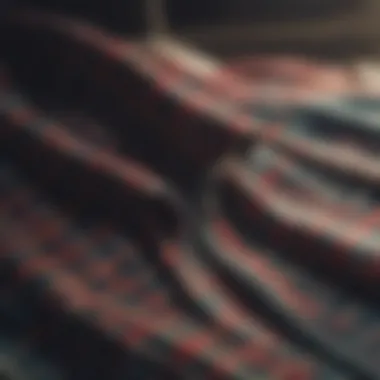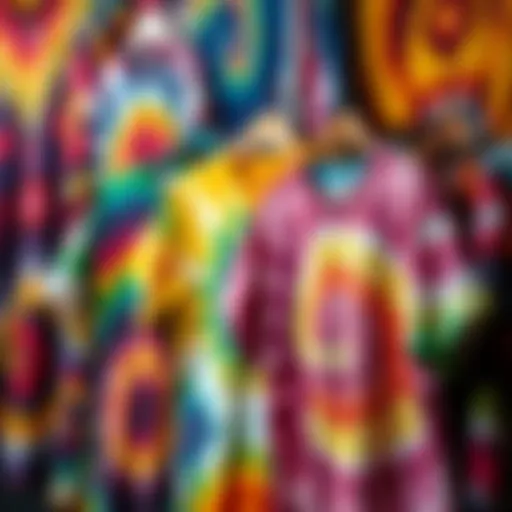American Flannel: Cultural Significance and Modern Uses


Intro
American flannel has more than just a cozy appeal; it carries threads of history, culture, and practical functionality. Once viewed simply as a fabric, flannel has transcended its basic origins to become a symbol interconnected with diverse lifestyles, notably within the skateboarding community. Its adaptation over the decades mirrors shifting trends in fashion, practical use, and environmental consciousness. As we journey through this exploration, we’ll shed light on the fabric’s evolution, its crucial role in American identity, and how it interfaces with modern sustainable practices.
Understanding American flannel goes well beyond fabric patterns or its role in a wardrobe. This material is interwoven with stories of labor, craftsmanship, and evolving identities. We will unpack how flannel emerged from the textile industry, gained a foothold in fashion, and intermingled with various subcultures that shaped its presence today. By examining contemporary adaptations and the focus on eco-friendly production methods, we’ll make a case for why this fabric is more than a mere staple; it’s an enduring symbol of resilience, expression, and style.
"Flannel represents comfort not only in tactile terms but also in its connection to community and ethics."
With these insights as our groundwork, let’s delve deeper into the actual tricks, techniques, and gear that highlight the interplay between American flannel and modern skate culture.
Historical Context of Flannel
Understanding the historical context of flannel allows us to appreciate not only the fabric itself but also its evolving role within American culture. Flannel, once a humble textile, has secured its place in the wardrobes of many, spanning generations and varying subcultures. Its journey from factories to fashion statements reflects broader societal trends and emphasizes the fabric's versatility.
Origin in Textile Manufacturing
Flannel's roots can be traced back to the early 17th century in Wales, where woolen fabric gained traction for its warmth and durability. Although its production methods were rudimentary by today’s standards, flannel soon became a staple among laborers and farmers alike due to its practicality. It was primarily made from carded wool, leading to a soft texture that provided comfort in chilly climates.
In America, the rise of the textile manufacturing industry during the Industrial Revolution witnessed a second wave of flannel's popularity. Factory systems needed efficient means of producing fabric, and flannel fit the bill perfectly.
"Flannel was a fabric born from necessity, designed to keep the workers warm while they toiled away, often in brutal conditions."
By harnessing new technologies like the spinning jenny and power loom, manufacturers could create flannel at unprecedented speeds. The introduction of cotton as a common ingredient contributed to its affordability, making it accessible to a broader segment of the population. Before long, this versatile fabric began showing up in various regions of the United States, seamlessly integrating into the lives of many.
Early Adoption in American Culture
Flannel didn’t just stay confined to the closets of the working class; it transitioned into a form of self-expression. By the late 19th century, flannel shirts developed into iconic pieces, especially among groups like gold miners and lumberjacks, who needed sturdy attire to withstand the demands of their hard-working lifestyles. In that sense, flannel became a symbol of ruggedness and the American spirit of perseverance.
In the 20th century, flannel's adoption kept pace with the changing cultural landscape. Influential figures in music and art began wearing flannel, elevating its status from mere workwear to a fashion statement. This transformation reflected a broader rebellion against formalism and an embrace of individuality that characterized various social movements.
As flannel shirts began to appear in youth subcultures, they echoed sentiments of authenticity and a connection to grassroots values. Colleges became a melting pot for young adults sporting flannel, tying it to a sense of identity and belonging. This fabric soon kicked the door open to explore the intersections of fashion with class, lifestyle, and culture, laying the groundwork for its contemporary relevance.
In summary, the origin and early adoption of flannel weave a narrative rich with historical implications. Both within the factory walls and the spirit of communities, this fabric serves as a testament to American ingenuity and resilience.
Flannel as a Fashion Element
Flannel's significance in the fashion landscape goes beyond its earthy textures and warm feel. It’s not merely about the cozy vibes; flannel embodies a cultural shift, evolving through time to reflect changing societal attitudes. As we peel back the layers on flannel as a fashion element, we'll reveal its multifaceted role in everyday wear and subcultural wardrobes alike.
Evolution Through the Decades
Looking back, flannel found its footing in the 18th century as a practical fabric for workers in the fields and factories. Over the decades, its narrative has been anything but static. The 1990s, in particular, heralded a renaissance for flannel shirts, driven by the grunge music scene. Artists like Kurt Cobain wore them as symbols of rebellion against mainstream fashion, turning what was utilitarian into a statement of identity.
Fast forward to today, and flannel continues its evolutionary journey. From oversized button-ups paired with skinny jeans to fitted styles under blazers, it adapts while maintaining its rugged charm. One can argue that flannel has become a necessary staple within wardrobes irrespective of gender, age, or style preference. Its popularity doesn’t seem to be fading; instead, flannel is adding new chapters to its legacy with every passing generation.
Influence of Music and Subcultures
Various musical movements have woven flannel into their identities, from the punk and grunge of the 80s and 90s to the contemporary hip-hop scene. Bands like Pearl Jam and Soundgarden catapulted flannel into the spotlight, giving it a rebellious edge that resonated with youth. Skate culture, too, has adopted flannel as a core element of its fashion lexicon. Skateboarders appreciate the fabric's lightweight nature while also benefitting from its durability—perfect for those unplanned falls.
Beyond music, flannel serves as a canvas for self-expression, often tied to local scenes. For example, urban skaters might pair their flannel with vibrant graphics and distressed jeans, contrasting richly textured flannel with streetwear aesthetics. This fusion illustrates how flannel transcends the simple utility of clothing to signify belonging within specific cultural contexts.
"Flannel is not just about warmth; it’s about identity. It brings together various cultural threads into one frothy fabric of social commentary."
American Flannel in Skate Culture
Flannel's journey into the heart of skate culture isn’t just about aesthetics; it's tied to a broader narrative regarding comfort, utility, and rugged individualism. Skate culture, often characterized by its rebellious spirit, finds a natural ally in flannel, which embodies a laid-back yet functional style. As skateboarders navigate urban landscapes, their clothing choices reflect more than just fashion—they're statements of identity and lifestyle.
Practical Benefits for Skateboarders


For skateboarders, practicality reigns supreme. Here's why flannel has become an essential part of their wardrobe:
- Durability: Flannel shirts are often made from resilient material that can withstand the rigors of skateboarding. The fabrics are designed to endure falls, scrapes, and the wear and tear of street skating.
- Comfort: Skateboarders need clothing that allows for freedom of movement. Flannel's loose fit provides ample flexibility, ensuring that the skater can perform tricks without feeling restricted.
- Breathability: Many flannel shirts are crafted with a level of breathability that makes them ideal for days spent on the board. Whether it’s a sunny afternoon or a brisk day, flannel keeps the skate enthusiasts comfortable.
"Comfort and functionality in clothing can make all the difference when you're riding around on a skateboard. Flannel checks all those boxes, so it's not hard to see its appeal within the community."
In addition to these benefits, there are seasonal advantages as well. When temperatures drop, flannel serves as a great layering piece, offering warmth without bulk, further solidifying its role as a go-to option in a skater's closet.
Style and Identity within the Skate Community
So, what’s the connection between flannel and skateboarding that makes it resonate deeply with skaters?
The relationship is often about community and identity. Within skate culture, flannel is more than just a clothing choice; it represents a certain attitude—one of rebellion against mainstream fashion and a nod toward individuality. The vibe that flannels give off fits perfectly into the skater ethos, which is often both casual and anti-establishment.
Moreover, members of the skate community often adopt flannel in personalized ways. It’s not unusual to see various patterns and colors being mixed and matched within a skate crew.
- Individual Expression: Skaters often turn flannel into a personal signature. Each skater might wear their flannel differently, whether tied around the waist, under a jacket, or worn oversized.
- Cultural Symbolism: The flannel shirt risks being perceived as a symbol of an era, reminiscent of grunge music and counter-culture. Casual yet significant, flannel appeals to a sense of nostalgia while integrating seamlessly into modern style.
Through skateboard documentaries, social media platforms, and grassroots movements, flannel has been immortalized within the skate community. From streetwear shots on Instagram to awe-inspiring documentaries about skate legends wearing flannel, its cultural relevance continues to blossom.
In summary, American flannel is more than just a fabric; it's a versatile ally for skateboarders, providing comfort and practical benefits while allowing for personal expression and representing deeper cultural ties. The way this fabric has embedded itself within skate culture shows just how much clothing can signify more than just coverage—it can reflect values and lifestyle choices.
Cultural Reconstructions Around Flannel
Flannel has woven its way into the cultural fabric of American society, transcending its initial utility as a durable textile. It holds layers of significance that speak to broader themes of identity, societal norms, and eco-consciousness. This section reflects on how flannel has become intertwined with cultural reconstructions, impacting not just fashion but social paradigms as well.
Flannel and Gender Norms
Flannel's journey through the landscape of gender norms is intriguing. Traditionally, flannel shirts were seen as rugged workwear for men engaged in labor-intensive jobs. However, as societal attitudes towards gender fluidity evolved, so too did the representations of flannel. Now, it’s common to see individuals of all genders embracing flannel as a symbol of comfort and rebellion against rigid gender roles.
For instance, in the 1980s and 1990s, the grunge movement popularized flannel shirts among a wider audience, often styled in an intentionally androgynous manner. Bands like Nirvana and Pearl Jam wore flannel not only as a fashion statement but as a rejection of excessive consumerism. Flannel shirts became emblematic of a counterculture that challenged conventional definitions of masculinity and femininity. Here, we see a reclaiming of flannel, transforming it from merely a male work shirt into a unisex staple.
As a result, modern fashion sees flannel worn on both ends of the gender spectrum. The fabric embodies a spirit of individuality and freedom, as people pair flannel with different styles—be it skinny jeans, skirts, or even joggers. This shift underscores how flannel contributes to an ongoing conversation about identity and expression.
Flannel in Eco-Conscious Movements
Alongside its cultural implications related to gender is flannel's role in eco-conscious movements. Environmental awareness has burgeoned in recent years, pushing consumers toward more sustainable choices in their wardrobes. Flannel, often made from natural fibers like cotton or wool, can be positioned as an eco-friendly alternative to fast fashion.
Consider the rise of brands prioritizing sustainable manufacturing practices. These companies focus on sourcing organic cotton, utilizing recycled materials, and maintaining ethical labor practices. This movement provides a dual benefit: flannel becomes a stylish choice while also contributing to a more sustainable future.
Furthermore, flannel's durability promotes longevity in clothing. It stands up to wear and tear; thus, consumers can keep it in their wardrobes longer, minimizing the need for constant replacements. This approach is essential in combating the throwaway culture that dominates today's fashion industry.
Some companies even promote "slow fashion," encouraging customers to invest in quality pieces rather than transient trends. Flannel fits perfectly in this narrative, often celebrating vintage or hand-me-down styles rather than new mass-produced options. Through such cultural reconstructions surrounding flannel, both individuals and brands are making strides towards a more sustainable and thoughtful approach to clothing.
"Fashion can be a mirror for society. As we evolve, so too does our relationship with materials like flannel, shifting its narrative from mere utility to meaningful representation."
Material Composition and Quality
Understanding the material composition and quality of flannel is crucial for appreciating its role both in fashion and practical application. Flannel is not just a simple fabric; it is a blend of comfort, durability, and style that has managed to capture the hearts of various communities, particularly skateboarders who value both aesthetic and functionality. The right type of flannel can provide warmth without bulk, allowing for effortless movement, which is something that skateboarders prioritize.
Types of Flannel Fabrics
Flannel comes in various types, each with unique characteristics that cater to different needs. A closer look reveals:
- Cotton Flannel: Soft and breathable, cotton flannel is a go-to for casual wear. It is often used in shirts and pajamas, appealing for its comfort against the skin.
- Wool Flannel: Known for its warmth, wool flannel can be a little prickly but offers insulation beyond what cotton provides. It’s ideal for cooler climates and can be found in jackets and outerwear.
- Polyester Blends: Often used in sportswear, polyester flannel increases durability and resistance to wrinkles, making it less prone to fading after washing. Skate enthusiasts sometimes prefer this for clothing that can withstand the wear and tear of their activity.
These various materials influence not just the feel of the fabric but also its practical applications in daily life. Choosing the right type can make a significant difference, especially for those engaging in active lifestyles.
Durability and Functional Aspects


When we discuss durability, flannel stands out thanks to its unique construction and fiber technology. The durability of flannel can be affected by several factors:
- Fabric Weight: Heavier flannels tend to be more robust. The density can offer greater resistance to abrasions, a vital factor for skateboarders who frequently experience falls or scuffs.
- Weaving Techniques: Different weaving methods can greatly affect the lifespan of flannel. For instance, twill weaves often provide extra strength while maintaining a soft touch.
- Finishing Processes: Modern manufacturing techniques can enhance the quality of flannel. Treatments that resist pilling and increase water resistance are becoming more common, offering functionality for everyday wear.
"Choosing flannel isn’t merely about style; it is about understanding fabric that can adapt, last, and perform in varied scenarios."
In summary, the material composition and quality of flannel are pivotal in determining its fit within both cultural and functional environments. For skateboarders and other style-conscious individuals, knowing what types of flannel exist and understanding how these fabrics hold up can lead to smarter choices in their wardrobe. The intersection of fabric choice and experience often creates a deeper appreciation of fashion beyond surface-level aesthetics.
Sustainable Practices in Flannel Production
Sustainable practices in flannel production have gained significant attention over the recent years. As consumers become more environmentally conscious, the demand for sustainable options in fashion has increased. Flannel, often associated with comfort and warmth, is now also seen as a potential player in the quest for ecological balance. This section explores the significance of sustainable practices concerning flannel production, highlighting ethical sourcing, manufacturing innovations, and the overall impact on the environment and society.
Ethical Sourcing of Materials
One of the cornerstones of sustainable flannel production is the ethical sourcing of materials. The choice of fabric matters. Traditional flannel, commonly made from cotton or wool, can often be linked to intensive farming practices that harm the environment. However, initiatives focusing on organic cotton are changing the game. Organic farming avoids the use of harmful pesticides and fertilizers, promoting biodiversity. Additionally, sourcing wool from farms that uphold animal welfare ensures that the sheep are treated humanely and live in well-maintained conditions.
Consider these points when discussing ethical sourcing:
- Local Farming: Supporting local farmers can reduce the carbon footprint associated with transport.
- Certification Standards: Look for certifications such as Global Organic Textile Standard (GOTS) that guarantee the materials meet high environmental and social standards.
- Transparency: Brands that share their sourcing practices foster trust and encourage more sustainable industry practices.
By prioritizing these ethical sourcing methods, flannel manufacturers not only adhere to sustainable principles but also cater to a market that increasingly values responsibility.
Manufacturing Innovations for Sustainability
Innovative approaches in flannel production are enabling manufacturers to minimize environmental impacts. The textile industry is notoriously resource-intensive, and flannel's popularity has led to pressing questions about waste and pollution levels. Innovations are paving new roads in sustainable manufacturing, making flannel production not just relevant, but responsible.
Some technologies and practices worth noting include:
- Waterless Dyeing Techniques: These methods utilize advanced technology that drastically cuts water consumption, reducing pollution from dye runoff.
- Recycling and Upcycling: Adopting methods to recycle and upcycle existing materials allows brands to reduce waste. This can include transforming discarded flannel into new products.
- Eco-Friendly Manufacturing Practices: Utilizing renewable energy sources in factories cuts down on additional carbon emissions from production.
"Sustainable practices in flannel production reflect a growing recognition that fashion can be both beautiful and ecologically mindful."
The shift towards greener practices not only benefits the planet but also aligns with the desires of consumers who wish to support brands that act with integrity. By focusing on ethical sourcing and embracing manufacturing innovations, the future of flannel can become synonymous with sustainability.
The Role of Flannel in Modern Wardrobes
Flannel has carved out a significant space in contemporary fashion, making its mark beyond the confines of casual wear. This fabric, with its soft texture and warm embrace, serves a dual purpose—practical and aesthetic. In modern wardrobes, flannel is not just a fallback for cool weather; it is a symbol of versatility and identity. When we dive deeper into how this fabric plays a role in our everyday attire, the practical benefits begin to unfold along with its multifaceted style potential.
Versatility Beyond Casual Wear
Flannel's adaptability is one of its standout qualities. Traditionally seen as a cozy shirt or blanket, it has transitioned into various forms of garments. Today, flannel can be dressed up or down, making it suitable for a wide array of occasions. Here are some ways flannel is making waves in modern wardrobes:
- Layering Piece: A well-fitted flannel shirt can be layered under a blazer or paired with a stylish jacket, adding depth to an outfit. This fluidity allows individuals to transition from a casual day at work to a night out with friends without missing a beat.
- Tailored Trousers: Flannel is no longer limited to shirts and jackets. Designers are now incorporating flannel into tailored trousers, allowing for a chic, sophisticated look without sacrificing comfort. The soft, breathable nature of flannel makes trousers easy to wear for prolonged periods.
- Dresses and Skirts: Flannel dresses and skirts are gaining traction among fashion-forward individuals. The unique patterns and colors of flannel provide a refreshing alternative to standard fabrics. With the right accessories, a flannel dress can easily take someone from a summer picnic to an autumn wedding.
The charm of flannel lies not only in its comfort but also in how it can reflect personal style. It invites creativity and experimentation, allowing wearers to pair it with unexpected elements—think flannel cuffs peeking out from under a tailored jacket or a bold statement necklace resting on a classic flannel shirt.
Influence of Social Media and Trends
Social media has positioned itself as a crucial player in steering fashion trends, and flannel is no exception. As Instagram and TikTok become the go-to platforms for style inspiration, the way flannel is showcased further promotes its relevance in modern wardrobes.
- Fashion Challenges: Various online challenges prompt users to showcase their flannel styles—be it through layered outfits or vintage-inspired looks. This creates a community of flannel enthusiasts sharing innovations, tips, and personal attire stories.
- Influencer Endorsements: Influencers often feature flannel in their outfits, positioning it as a staple for followers looking to emulate their style. Brands partner with influencers to create flannel-centric looks that reflect current trends, making it more accessible and desirable to a younger audience.
- Hashtags and Discovery: Hashtags like #FlannelFashion or #FlannelStyle gain traction, making it easier for individuals to discover creative ways to integrate flannel into their wardrobe. Social media thus serves as a virtual runway, shaping perceptions of how flannel can suit both leisurely and formal occasions.
Flannel's journey from mere fabric to a statement piece exemplifies the dynamic interplay of comfort, identity, and current fashion trends.
Global Interpretations of Flannel
Flannel, often perceived as a quintessentially American fabric, has morphed and adapted itself across various cultures around the globe. This versatility not only showcases the textile's universal appeal but also highlights its ability to merge with diverse cultural identities and practices. Understanding global interpretations of flannel unveils essential insights into fashion evolution and cultural appropriations, illustrating how a single fabric, originally cherished for its durability and comfort, can transcend its humble beginnings and find relevance in different contexts.
Variations in Design and Usage Worldwide


In various countries, flannel has taken on unique forms and uses that reflect local tastes and needs. For instance, in the United Kingdom, traditional tartan flannels are popular, often associated with Scottish heritage. The Scottish regard their flannel as a symbol of regional pride, infused with family history and cultural narratives tied to specific patterns.
In stark contrast, Japan has adopted and adapted flannel in various ways, producing styles characterized by fabric thickness and weaving techniques. Japanese flannel shirts, for instance, often feature intricate designs and a more tailored fit, offering a sophisticated twist on a casual staple. This juxtaposition of rugged American flannel with refined Japanese aesthetics reveals how the same material can communicate different messages across cultures.
Across the globe, from the rugged hills of the American Rockies to the bustling streets of Tokyo, flannel serves as a bridge between practicality and personal expression. Here are some notable variations:
- North America: Oversized flannel shirts, often used in layering, are popular among outdoor enthusiasts and in urban settings alike.
- Europe: Flannel is sometimes used in menswear suits, stitched with a refined finish that elevates its presence in formal attire.
- South America: Brightly patterned flannel is sometimes showcased in festival wear, indicating a playful and vibrant adaptation.
The global variations in flannel’s uses demonstrate its inherent quality and versatility, proving that a fabric can be both practical and stylish across continents.
Flannel’s Role in International Fashion
Flannel has transcended its role as merely a functional fabric to become a pivotal element in international fashion discussions. Designers around the globe incorporate flannel into their collections, pairing it with elements that reflect cultural sentiments. For example, since the early 90s, flannel has been an indispensable fabric in punk and grunge fashion, creating a rebellious look that resonated with youth culture, especially in the United States and parts of Europe.
Today, fashion houses in Milan and Paris frequently showcase tailored flannel suits, aligning with current trends that blur the lines between casual and formal. This evolution of flannel into high fashion signifies its adaptability and the growing recognition of its varied personality in a global context.
Moreover, social media platforms like Instagram and Pinterest fuel flannel's presence in international fashion trends, allowing creators and retailers to share unique styles and outfits featuring flannel, reaching a broader audience. Hashtags like #FlannelFashion and #FlannelStyle highlight this fabric’s enduring allure.
"Flannel is not just a shirt; it is a canvas for self-expression, touching every corner of the globe with its threads."
As flannel experiences a renaissance in contemporary fashion, it can be observed in various contexts, promoting eco-consciousness and sustainability through careful sourcing and ethical manufacturing practices. Its journey across cultures emphasizes that while styles may vary, the essence of flannel remains rooted in simplicity, comfort, and functionality, a testament to its lasting legacy in wardrobes worldwide.
Personal Narratives and Flannel
The exploration into American flannel would feel incomplete without acknowledging the personal stories attached to this iconic fabric. Flannel is not just a garment; it's tied to memories, identities, and cultural expression. For many, the fabric evokes a sense of nostalgia or belonging. When people don flannel shirts, they often wrap themselves in experiences that span generations and evoke long-forgotten feelings. Such narratives provide context to the garment, illustrating its role in personal lives and broader social constructs.
Flannel connects various threads of experience across age and background. For skateboarders, the fabric has become entwined with their lifestyle and aesthetic. Adding emotional dimension to this simple shirt transcends the realm of fashion trends. If a piece of clothing can anchor someone in a particular moment or evoke a key experience, its significance skyrockets. Much like how the threads interweave to form the fabric, individual narratives create a rich tapestry of meaning attached to flannel.
Interviews with Skateboarders
Delving deeper into the world of skateboarders reveals how flannel shapes not just their outerwear but also influences their identity and group dynamics. Interviews conducted with various skateboarders showcase a recurring theme: a strong connection to flannel as a wardrobe choice. Each skater, with their unique flavor and flair, seems to have a story linked to the decision to wear flannel.
Take Sarah, for instance, a passionate skateboarder from California. She tells of her first flannel purchase at a secondhand store, simply drawn in by the colors. What started as a fashion whim soon became a staple in her skating apparel. Sarah shared how, for her, flannel has always felt like a nod to the gritty authenticity within the skateboard community.
Similarly, Josh, a skater from New York, recounted his upbringing where flannel adorned the backs of both his father and grandfather. It wasn't just about wearing flannel; it was about continuing a legacy. “Every time I put this on, I feel them with me,” he said. What emerges from these narratives is an understanding that flannel is a bridge connecting generations and community.
Cultural Stories Linked to Flannel
Flannel's place in cultural stories extends beyond individual experiences; it taps into the very essence of various movements and social changes. From the Grunge movement in the 1990s to today's eco-conscious efforts, flannel serves as a canvas reflecting not just personal style but cultural shifts.
Historically, it was linked to the working class, often connected with the rugged, reliable lifestyle. Flannel shirts were functional, and practical. Today, it has transcended those roots, embodying ideas of rebellion and self-expression. Many artists have donned flannel in their videos, reinforcing its role in shaping new cultural narratives.
Social media has flooded the flannel scene with a tapestry of stories. Online communities share not only their outfits but also the tales behind them. Individuals post images of themselves sporting flannel at protests or community events, marrying the fabric with ideals like activism and solidarity.
"Flannel is more than just plaid fabric; it's a storytelling medium that connects hearts and narratives."
Future Prospects of Flannel
The discussion surrounding the future prospects of flannel is not just about the fabric itself but considers its role in an ever-changing cultural landscape. Flannel carries with it historical significance, but it also embodies adaptability and resilience, crucial traits in a world that is increasingly aware of fashion’s environmental implications. Its versatile nature offers a platform for sustainable practices while maintaining stylish relevance.
Anticipated Trends in Fashion
As we step into the next phase of fashion evolution, flannel is poised to remain a key player. Here are some anticipated trends worth considering:
- Layering Techniques: Upcoming fashion looks are likely to emphasize layering, favoring flannel shirts as base pieces that can coexist with various outerwear. Layering not only increases warmth but also allows for personal expression through mix-and-match styles.
- Collaborations with Sustainable Brands: Flannel's connection with eco-consciousness could lead to innovative partnerships. Expect to see collaborations where premium flannel materials are sourced ethically, thus appealing to a growing market of conscientious consumers who care about the origins of their clothing.
- Statement Pieces: Designers might incorporate flannel into high fashion. Instead of simply utilitarian wear, we might see flannel morph into haute couture—think tailored jackets or stylish flannel dresses, definitely leaving behind its humble roots.
Potential for Innovative Designs
Looking ahead, the potential for innovative designs in flannel is vast. The fabric is ripe for experimenting, opening doors to not just aesthetic innovations but functional advancements too. Here are potential design avenues:
- Tech-Enhanced Fabrics: The integration of smart textiles with flannel could yield garments that regulate temperature or even repel dirt and stains, making it not only fashionable but also highly practical.
- Customizable Elements: With advances in digital printing, customization of patterns and colors will likely become more mainstream. This can allow consumers to design their own flannel shirts, encapsulating both individuality and creativity.
- Hybrid Styles: Designers might blend flannel with other fabric types, leading to unique hybrids that could redefine what flannel looks and feels like. Envision flannel-lined denim jackets or flannel mixed with stretchy materials for a more athletic appearance.
"In the next few years, flannel is set to reinvent itself, maintaining its core warmth and authenticity while also adapting to modern demands. The sky's the limit!"
Through these developments, flannel will continue to bridge the gap between comfort and contemporary style. Its ability to evolve alongside societal shifts will place it firmly in the spotlight, ensuring its relevance for years to come.



